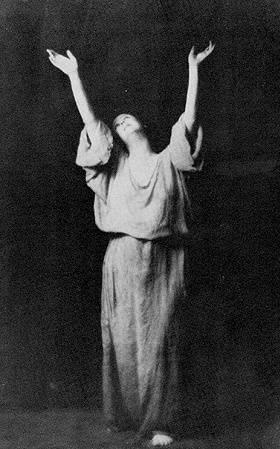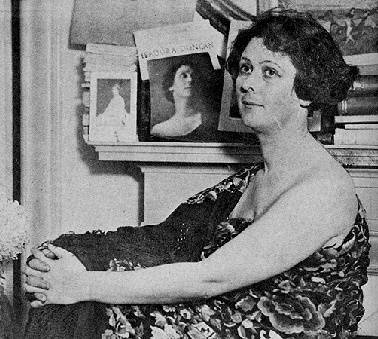Isadora Duncan
Historical Essay
by Jodi Lomask, 1997
Isadora Duncan dancing.
Photo: San Francisco Performing Arts Library
Isadora Duncan, born in San Francisco in 1877, was possibly the most influential advocate of modern dance internationally in the twentieth century. She brought her freeform movements and her toga-style dress, modeled after Greek sculpture, to packed audiences in dozens of countries. Duncan gave expressionist dance words through her books (My Life, The Art of Dance), speeches, and letters to the newspapers: "What I am interested in doing is finding and expressing a new form of life" Duncan declared in The Mentor (February 1930).
In a period during which art dance was limited to entertainment, corsets, and a Ballet vocabulary, Duncan revealed the revolutionary potential of body-movement art once freed from restricting garb, "technique", and the economic constraints of the bourgeois audience: "I left Europe where art is closely linked with commerce. And it will be contrary to all my convictions and wishes if I shall again have to give paid performances to a bourgeois public."
Isadora Duncan backstage.
Photo: San Francisco Performing Arts Library
Duncan was inspirational to poets, artists of many disciplines, and revolutionaries: "There is just one thing that astonishes me. That is to hear that the American government has no sympathy with revolutions. I had always been taught that our great country was started by a revolution..."
Duncan's quest was to express the inner landscape through her body. It was not to achieve virtuosity of form or strength of line: "No pose, no movement, no gesture is beautiful in itself. Every movement is beautiful only when it is expressed truthfully and sincerely. The phrase 'the beauty of line' is—by itself—absurd. A line is beautiful only when it is directed toward a beautiful end."
She spent her childhood moving from one poor apartment to another with her mother and two sisters, and dancing alone by the sea. Her mother, though struggling to support the family on her own after Duncan's father left her, found the energy to expose her children to fine arts and literature: "When I could escape from the prison of school, I was free ... My real education came during the evenings when my mother played to us Beethoven, Schumann, Schubert, Mozart, Chopin, or read aloud to us from Shakespeare, Shelley, Keats, or Burns," Duncan wrote in My Life.
Hardships in Isadora's life inspired her vision, which primarily was a free school for children which she believed would be the lever to move the world: "When I speak of my School, people do not understand that I do not want paying pupils; I do not sell my soul for silver. I do not want the rich children. They have money and no need for Art. The children I long for are the orphans of the war, who have lost everything, who no longer have their fathers and mothers. As for me, I have little need of money. Look at my costumes. They are not complicated; they did not cost very much. Look at my decors, these simple blue curtains I have had since I first started dancing. As for jewels, I have no need for them. A flower is more beautiful in the hands of a woman than all the pearls and diamonds in the world."
Duncan supported many new ways of living including vegetarianism and birth control. A believer in the Bolshevik revolution in Russia, she declared free art necessary to Communism: "The children of Communists still receive an essentially old-fashioned bourgeois education. If you want the future generation to understand the nature of Communism and the International, you must today free the child from the slavery of bourgeois education and prejudices."
The Commissariat of Education in Russia gave Duncan a house and grounds to start her school, along with one thousand children the first year. Duncan traded the packed Opera houses of Europe for the bare existence in Communist Russia. Comrade Podvoisky told Duncan upon her arrival, "In your life you have known great theaters with applauding publics. That is all false. You have known trains du luxe and expensive hotels. That is all false. Ovations -- false. All false. Now you've come to Russia ... if you want to work for Russia ... go alone amongst the people. Dance your dances in little barns in the winter, in open fields in the summer. Teach the people the meaning of your dances. Teach the children. Don't ask for thanks." After a famine her school was cut down to twenty students.
She voiced strong support of the liberation of women, children, and the working class, all of which she saw in reference to the spirit of humankind. At twelve years old, she resolved to "live to fight against marriage and for the emancipation of women," she recalled in My Life. "So long as children are allowed to suffer, there is no love in the world."
Isadora Duncan's most revolutionary quality was her public honesty as one can see here in these statements to the press concerning her marriage to a Russian poet named Esenin whom she described as " a genius ... mad as a hatter, strong, full of vitality." She brought him to the United States and eventually helped him return to Russia. "I never believed in marriage. I married Serge to enable him to get a passport to America ... marriage between artists is impossible. Serge loves the ground I walk on. When he goes mad he could kill me-he loves me so much more, then. For four months I worked with Serge. He is the loveliest boy in the world, but a victim of fate. Like all geniuses, he's cracked. I've given up hope of ever curing him of his occasional madness."
In Isadora Duncan's own words, "Yes, I am a revolutionist. All true artists are revolutionists."


